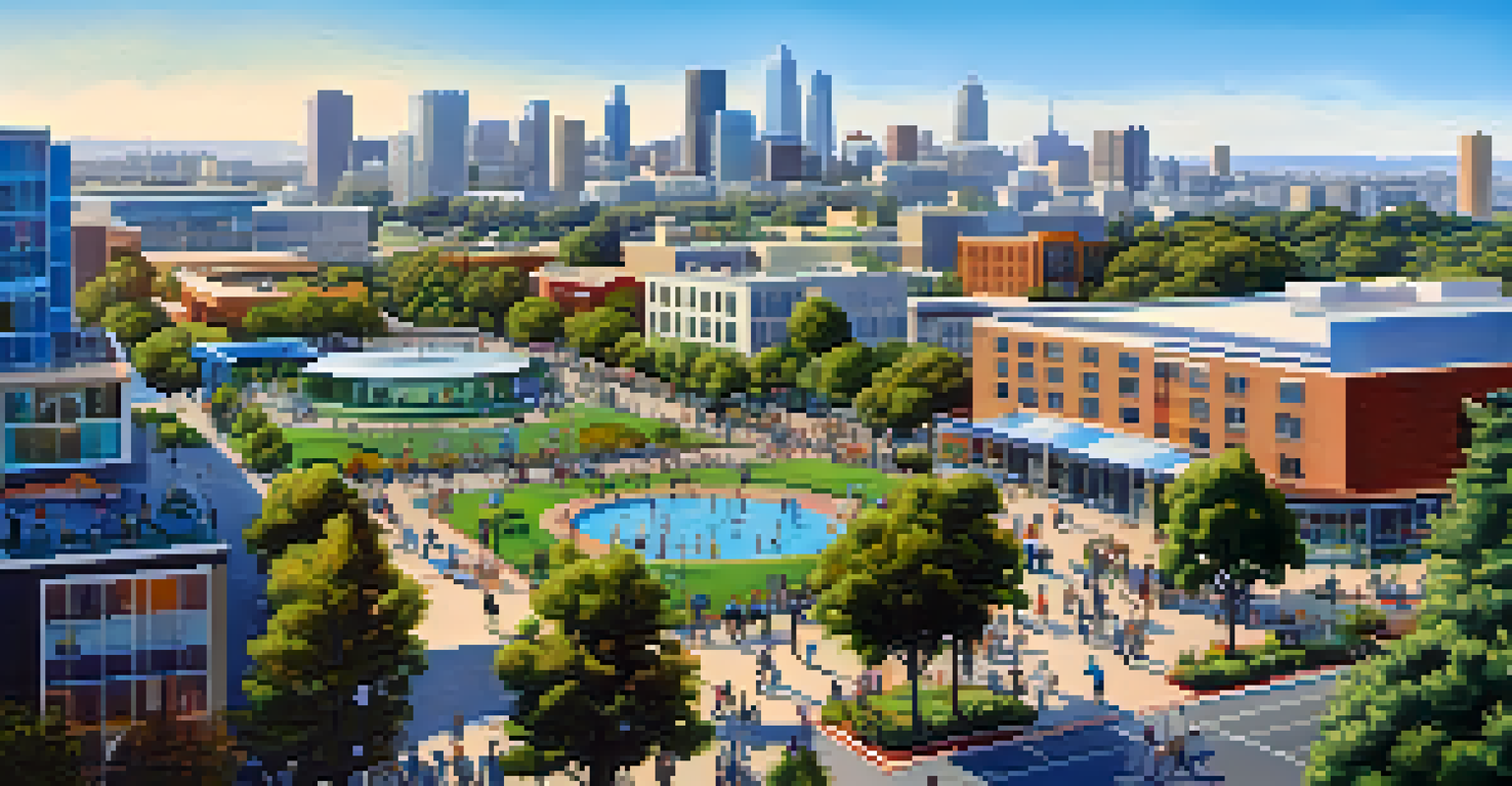Economic Changes in Redwood City: A Historical Perspective

The Early Economic Foundations of Redwood City
Redwood City's economic journey began in the mid-19th century, primarily driven by the timber industry. The abundance of towering redwoods attracted settlers and entrepreneurs alike, leading to the establishment of sawmills that fueled the region's growth. As shipbuilding and lumber exports flourished, Redwood City quickly transformed into a bustling port town on the San Francisco Peninsula.
The greatest danger in times of turbulence is not the turbulence—it is to act with yesterday's logic.
By the late 1800s, the introduction of the Southern Pacific Railroad further connected Redwood City to the broader economy of California. This transportation link not only facilitated the movement of goods but also encouraged residential development, attracting a diverse population drawn by economic opportunities. The town's strategic location helped it become a hub for trade and commerce.
The economic landscape during this period laid the groundwork for future growth. As industries evolved, Redwood City began to diversify beyond timber, setting the stage for a more complex economic structure. This early foundation was crucial in shaping the community's identity and its resilience in adapting to changing economic climates.
The Impact of the 20th Century on Redwood City's Economy
As the 20th century unfolded, Redwood City's economy faced significant transformation, marked by the decline of the timber industry. The rise of technology and the automotive industries shifted the economic focus, and the city began to embrace its role as a suburban community. This transition brought about new job opportunities and a flourishing commercial sector.

During the post-World War II era, Redwood City experienced rapid population growth, which in turn spurred the development of infrastructure and services. New businesses emerged, and the city became a desirable location for families and professionals seeking a better quality of life. The establishment of schools, parks, and shopping centers contributed to the overall economic vitality.
Redwood City's Economic Evolution
The city's economy has transformed from a timber-based industry in the 19th century to a tech-driven hub, adapting to various economic challenges over time.
However, this period was not without challenges; the city had to balance growth with maintaining its historical charm. As it navigated these changes, Redwood City began to redefine its economic identity, laying the groundwork for the tech-driven landscape that would emerge in the following decades.
The Tech Boom and Its Influence on the Local Economy
The 1990s and early 2000s marked a significant turning point for Redwood City, as the tech boom transformed the local economy. With the rise of Silicon Valley, many technology companies began to flock to the area, drawn by its ideal location and resources. This influx not only created thousands of jobs but also changed the demographic makeup of the city.
Innovation distinguishes between a leader and a follower.
As tech companies established their headquarters, Redwood City's economy diversified further, shifting from a reliance on traditional industries to becoming a hub for innovation. The presence of well-known companies attracted talent from around the globe, fostering a vibrant community filled with entrepreneurs and tech professionals. The economic landscape became increasingly dynamic, driven by innovation and investment.
However, this rapid growth also led to challenges, such as skyrocketing housing prices and increased traffic congestion. City officials recognized the need to balance economic development with maintaining a livable community, which has become a central theme in Redwood City's ongoing economic narrative.
Redwood City's Response to Economic Challenges
In response to the challenges posed by rapid growth and economic shifts, Redwood City has implemented various strategies to foster sustainable development. City planners have focused on creating a balanced economy, emphasizing the importance of mixed-use developments that cater to both residential and commercial needs. This approach aims to maintain the city's charm while accommodating new growth.
The city has also prioritized investments in public transportation and infrastructure to ease congestion and improve accessibility. By enhancing transit options, Redwood City aims to reduce reliance on cars and promote a more walkable community. These efforts not only benefit residents but also attract businesses looking for a vibrant and accessible location.
Balancing Growth and Livability
Redwood City faces the challenge of balancing rapid economic growth with maintaining housing affordability and community charm.
Additionally, Redwood City has embraced its cultural heritage, promoting local businesses and events that celebrate its history. By fostering a sense of community and preserving its unique character, the city seeks to create an environment where both residents and businesses can thrive together.
The Role of Local Government in Economic Development
Local government plays a pivotal role in shaping Redwood City's economic landscape. Through various initiatives, the city has worked to create a favorable environment for businesses while ensuring that growth aligns with community needs. This includes offering incentives for startups and established companies alike to set up shop in the area.
Moreover, Redwood City's leadership has actively engaged with residents to gather feedback on economic strategies. This collaborative approach fosters transparency and ensures that the voices of the community are heard in decision-making processes. By prioritizing stakeholder input, the city can better navigate the challenges and opportunities presented by a changing economy.
In recent years, Redwood City has emphasized the importance of sustainability in its economic development plans. By integrating eco-friendly practices into new developments and supporting green initiatives, the city aims to position itself as a leader in environmentally responsible growth, appealing to both residents and businesses that value sustainability.
The Future Economic Outlook for Redwood City
Looking ahead, Redwood City is poised for continued economic evolution, driven by technology and innovation. As the tech industry continues to thrive, the city is positioned to attract new businesses and talent, further enhancing its reputation as a vibrant economic hub. This growth presents opportunities for diversification and resilience against economic downturns.
However, challenges remain, particularly concerning housing affordability and infrastructure demands. The city must find ways to balance growth while ensuring that all residents can enjoy the benefits of a thriving economy. Ongoing efforts to develop affordable housing and improve public services will be critical in maintaining a high quality of life for current and future residents.
Sustainability in Economic Development
Local government initiatives emphasize sustainability and community engagement, aiming to create an inclusive environment for both residents and businesses.
Ultimately, Redwood City's ability to adapt to changing economic landscapes will define its success. By embracing innovation, fostering community engagement, and prioritizing sustainability, the city can navigate the complexities of its economic future while preserving the unique character that makes it a beloved place to live and work.
Conclusion: Reflecting on Redwood City's Economic Journey
Redwood City's economic story is one of resilience, adaptation, and growth. From its humble beginnings rooted in the timber industry to its current status as a tech-driven hub, the city has navigated numerous challenges and transformations. Each chapter of its history has contributed to a rich tapestry that defines the community today.
As Redwood City continues to evolve, it remains essential to honor its past while embracing the future. The lessons learned from its economic journey can guide decision-makers and residents alike in shaping a sustainable and inclusive community. By fostering a collaborative spirit, the city can ensure that all voices are heard in its ongoing development.

In conclusion, Redwood City's economic changes reflect broader trends in California and the United States, showcasing the importance of adaptability and community engagement. As we look to the future, the city's commitment to innovation, sustainability, and inclusivity will be key in navigating the complexities of a rapidly changing economy.